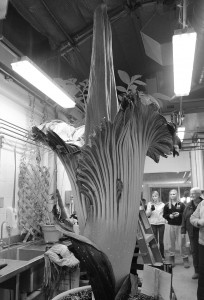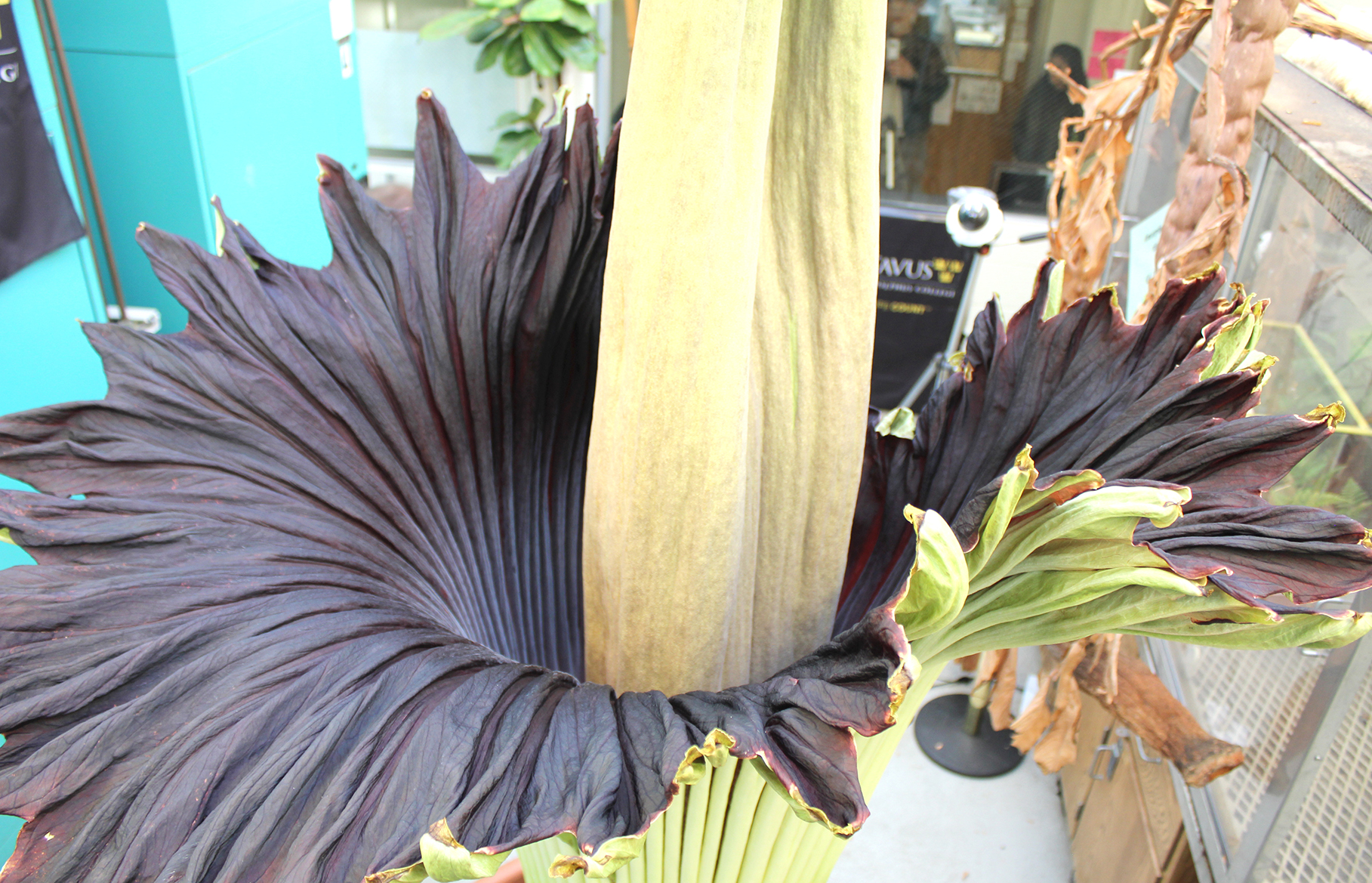Nobel Hall was brimming both with excitement and a curious aroma on Thursday, Oct. 31 when Perry the Corpse Flower bloomed.
Chemistry Professor Brian O’Brien received the seeds from James Symon, a physician from San Francisco, California. Symon had been traveling to view exotic plants and collected seeds from the Corpse Flower as it grew increasingly threatened by deforestation.
“It grows only on the Island of Sumatra in Indonesia and in a fairly limited range even there,” O’Brien said.
He said that the seeds he received from Symon in 1993 proved surprisingly easy to grow.
The greenhouse uses a mixture of ordinary potting soil with additional compounds to improve draining properties, as well as surface compost.
This is the third time Perry has bloomed at Gustavus. The first time, in 2007, drew an estimated 7,000 visitors. The second blooming in 2010 attracted a crowd of around 5,000.
Junior Nate Friedley, who works in the campus greenhouse in Nobel Hall of Science, has been welcoming visitors.
“For as long as I’ve been there, Perry’s just been a leaf, and so now that he’s becoming a flower, he’s getting a lot more attention,” Friedley said.
The name “Perry” was bestowed upon the plant early in its life. O’Brien, his colleagues, and several students, decided to name the plant after one of the titans. Eventually, Hyperion, was selected and was shortened to Perry, according to O’Brien.
The Corpse Flower, or Amorphophallus titanum, begins as a seed about the size of an almond, and subsequently goes through several cycles of growth and dormancy. A leaf grows from the root system, or corm, which according to Professor O’Brien will develop to resemble a giant one-eyed potato. The leaf and corm will grow increasingly large after each cycle as the plant gathers nutrients. After many cycles, O’Brien now estimates that Perry’s corm weighs around 150 pounds.
Every several cycles, the plant will develop and blossom into the display that dazzled spectator’s eyes and noses last week.
Corpse flowers only bloom and emit the notable odor for a brief time.

“It takes about six weeks or so from when you first see the shoot to when it opens, roughly, and then it doesn’t last very long. Actually, it’s at its peak for probably 12 hours or so [before it begins to wilt],” O’Brien said.“So basically, it’s like a one day flower.”
“We think it’s a spectacular example of this biological diversity, and it’s a wonderful example of evolutionary adaptations by plants,” O’Brien said. “It’s become a really beautiful, magnificent thing to see and a lot of people are just impressed not only with the fragrance, but with the sculptural presence that it has and all the textures and colors that you see in various parts of the plant.”
While the bloom resembles a single enormous blossom, O’Brien explained that the plant actually produces an inflorescence, or ring of individual flowers within the outer cone, or spathe. The large spadix rises from the center of the plant.
“We get asked about the feel of the different parts of the plant. The spadix is waxy and it’s like a soft plastic kind of when you push on it,” Adjunct Instructor Terena Wilkens said.
Wilkens has volunteered in the greenhouse for the past two bloomings.
“At one point, the spadix, which is the very top of it, was at 101 degrees, and that’s when it was at its worst,” Wilkens said.
A webcam has been consistently recording Perry since 2007, though increased attention is given to the live feeds when the blooming draws near.
Gustavus students, local high school students, and other visitors streamed through the greenhouse to catch a glimpse of Perry in person. The plant has grown to reach a little more than seven feet in height.
A guestbook invited guests to record how individuals would define the scent. O’Brien has captured reactions and observations in a blog through the Linnaeus Arboretum.
For O’Brien, Perry holds special significance.
“I’ve wanted to work with this plant since I was about seven years old. I first learned about it reading my Grandma’s gardening encyclopedias, and there was a picture of it of a botanist standing next to one of these in bloom, and I wanted to see one ever since,” O’Brien said.
“So it’s kind of cool to have this kind of plant that I never knew if I’d ever see during my lifetime, just growing down the hall from my office,” O’ Brien said.
To observe and recapture Perry’s rapid growth this year, visit https://gustavus.edu/biology/titanarum/.
